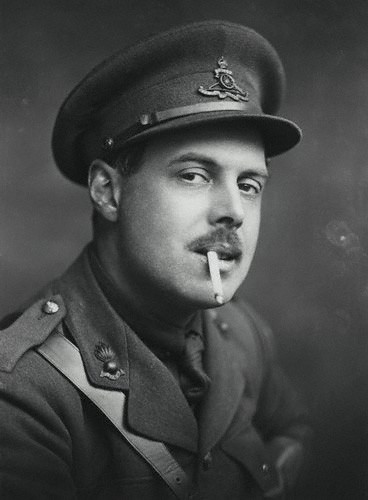A hundred years ago this month, a young and ambitious artist fell out with his boss and, inspired by the Italian Futurists, rebelled against what he perceived to be a stifling, polite view of what art should be. His revolt initiated a short-lived movement that would shock the establishment and change British culture. His name was Wyndham Lewis, and the movement he started was, of course, Vorticism.
Lewis had been working at Roger Fry’s Omega Workshop in Fitzroy Square, and was becoming increasingly angry at Fry’s gutlessly tasteful house style and, perhaps more significantly, at Omega’s failure to credit individual artists for their work. Lewis believed that art’s purpose was not to reflect an ideal, but rather, as he would write in the Vorticist manifesto, to ‘find the same stimulus as nature’, conjuring all the ‘chaos’ and ‘discord’ that it entailed.
After finally losing patience with Fry over an installation at the Daily Mail’s Ideal Home Exhibition, Lewis walked out for good, decamping to a now-demolished house at 38 Great Ormond Street. It was dubbed the ‘Rebel Art Centre’, attracting several like-minded artists inspired by Cubism and Futurism, including Edward Wadsworth and the French sculptor Henri Gaudier-Brzeska.

Self-portrait (1913), Henri Gaudier-Brzeska. Source: Wikimedia Commons
The Centre’s purpose, according to Richard Cork in Art Beyond the Gallery in Early 20th-Century England, was ‘not for an Omega-style bottega where clients’ commissions were executed, but for an ‘Art School’ offering ‘instruction in various forms of applied Art’. Members of the group painted murals, screens and friezes, and used the building as a studio for more particular projects of their own. Various speakers were brought in to give talks – Lewis even managed to coax Marinetti to Great Ormond Street, where he spent his ‘lecture’ impersonating a steam train.
Although ‘Vorticism’ is thought to be the neologism of Ezra Pound, Lewis came up with several explanations for it. According to Cork, he initially talked the movement up as a ‘whirlpool’, but years later would claim the term originated in ‘the idea of a mass of excited thinking, engrossed in a whirling centre.’
The best of the Vorticists’ art certainly evokes this; Gaudier-Brzeska’s muscular but fluid sculptures and David Bomberg’s rhythmic and dazzlingly energetic paintings are perhaps the best examples. Lewis’s own work of the period, to put it diplomatically, was not his most memorable. His major contribution to Vorticism was his unrestrained genius for self-publicity and sloganeering.

(Percy) Wyndham Lewis (1917), George Charles Beresford. National Portrait Gallery. Photo: Wikimedia Commons
The most obvious manifestation of this came with BLAST, the literary magazine launched by from the Centre in July 1914. With its bold-printed, single-word title against a striking magenta background, its cover was an influential statement of intent. In terms of significance, BLAST‘s closest equivalent of recent years would probably be ‘Freeze’, the 1988 warehouse exhibition credited with launching the Young British Artists as a phenomenon.
This, though, would be to understate the case considerably. The roll-call of contributors to the first edition of BLAST throws up a staggering number of influential names; aside from Pound and Lewis, it featured paintings and a review by Edward Wadsworth, drawings by Jacob Epstein, Gaudier-Brzeska’s Stags, and a story by Rebecca West. Perhaps most importantly, it also contained Ford Madox Ford’s The Saddest Story, a trial run for the author’s pioneering modernist novel The Good Soldier.
Much of its content, including Lewis’s Vorticist Manifesto, borders on cringe-worthy. ‘The inevitable paradox has occurred. Futurism is a thing of the past. Vorticism has come,’ a contemporary article in the New York Times declared, mocking the short but grandiose sentences penned by Lewis.
To concentrate on these false steps, though, is to ignore how shocking BLAST must have been – what Eric Hobsbawm called the ‘Long 19th Century’ was yet to end, and the complacency that defined Edwardian society was still very much in place. BLAST, with its violent emphasis on modernity, was the antithesis of this, a direct provocation. Here, a comparison with the Punk aesthetic of the late 1970s is inevitable – it wasn’t for nothing that Sex Pistols ‘svengali’ Malcolm McLaren cited Wyndham Lewis as an influence.
But ‘BLAST’ was to prove a tragically ironic title; just over a month after its publication, Austria-Hungary’s invasion of Serbia toppled the fragile balance of diplomacy in Europe and one by one the Great Powers threw themselves into what would become the world’s first truly industrial war. The Centre’s activity was wound down and Vorticism began to lose its momentum.
A second and final edition of BLAST appeared in 1915, but by this time the group was all but defunct. The mass slaughter of the conflict – in which Gaudier-Brzeska was killed at the age of 23 – suddenly made Vorticism’s enthusiasm for martial language and mechanical imagery seem ill-advised, if not downright tasteless. For a brief moment, though, 38 Great Ormond Street had become the fulcrum of the global avant-garde, the building where British art was kicked explosively into the 20th century.

BLAST: Wyndham Lewis and Vorticism, 100 years on
(Percy) Wyndham Lewis (detail; 1917), George Charles Beresford, National Portrait Gallery. Photo: Wikimedia Commons
Share
A hundred years ago this month, a young and ambitious artist fell out with his boss and, inspired by the Italian Futurists, rebelled against what he perceived to be a stifling, polite view of what art should be. His revolt initiated a short-lived movement that would shock the establishment and change British culture. His name was Wyndham Lewis, and the movement he started was, of course, Vorticism.
Lewis had been working at Roger Fry’s Omega Workshop in Fitzroy Square, and was becoming increasingly angry at Fry’s gutlessly tasteful house style and, perhaps more significantly, at Omega’s failure to credit individual artists for their work. Lewis believed that art’s purpose was not to reflect an ideal, but rather, as he would write in the Vorticist manifesto, to ‘find the same stimulus as nature’, conjuring all the ‘chaos’ and ‘discord’ that it entailed.
After finally losing patience with Fry over an installation at the Daily Mail’s Ideal Home Exhibition, Lewis walked out for good, decamping to a now-demolished house at 38 Great Ormond Street. It was dubbed the ‘Rebel Art Centre’, attracting several like-minded artists inspired by Cubism and Futurism, including Edward Wadsworth and the French sculptor Henri Gaudier-Brzeska.
Self-portrait (1913), Henri Gaudier-Brzeska. Source: Wikimedia Commons
The Centre’s purpose, according to Richard Cork in Art Beyond the Gallery in Early 20th-Century England, was ‘not for an Omega-style bottega where clients’ commissions were executed, but for an ‘Art School’ offering ‘instruction in various forms of applied Art’. Members of the group painted murals, screens and friezes, and used the building as a studio for more particular projects of their own. Various speakers were brought in to give talks – Lewis even managed to coax Marinetti to Great Ormond Street, where he spent his ‘lecture’ impersonating a steam train.
Although ‘Vorticism’ is thought to be the neologism of Ezra Pound, Lewis came up with several explanations for it. According to Cork, he initially talked the movement up as a ‘whirlpool’, but years later would claim the term originated in ‘the idea of a mass of excited thinking, engrossed in a whirling centre.’
The best of the Vorticists’ art certainly evokes this; Gaudier-Brzeska’s muscular but fluid sculptures and David Bomberg’s rhythmic and dazzlingly energetic paintings are perhaps the best examples. Lewis’s own work of the period, to put it diplomatically, was not his most memorable. His major contribution to Vorticism was his unrestrained genius for self-publicity and sloganeering.
(Percy) Wyndham Lewis (1917), George Charles Beresford. National Portrait Gallery. Photo: Wikimedia Commons
The most obvious manifestation of this came with BLAST, the literary magazine launched by from the Centre in July 1914. With its bold-printed, single-word title against a striking magenta background, its cover was an influential statement of intent. In terms of significance, BLAST‘s closest equivalent of recent years would probably be ‘Freeze’, the 1988 warehouse exhibition credited with launching the Young British Artists as a phenomenon.
This, though, would be to understate the case considerably. The roll-call of contributors to the first edition of BLAST throws up a staggering number of influential names; aside from Pound and Lewis, it featured paintings and a review by Edward Wadsworth, drawings by Jacob Epstein, Gaudier-Brzeska’s Stags, and a story by Rebecca West. Perhaps most importantly, it also contained Ford Madox Ford’s The Saddest Story, a trial run for the author’s pioneering modernist novel The Good Soldier.
Much of its content, including Lewis’s Vorticist Manifesto, borders on cringe-worthy. ‘The inevitable paradox has occurred. Futurism is a thing of the past. Vorticism has come,’ a contemporary article in the New York Times declared, mocking the short but grandiose sentences penned by Lewis.
To concentrate on these false steps, though, is to ignore how shocking BLAST must have been – what Eric Hobsbawm called the ‘Long 19th Century’ was yet to end, and the complacency that defined Edwardian society was still very much in place. BLAST, with its violent emphasis on modernity, was the antithesis of this, a direct provocation. Here, a comparison with the Punk aesthetic of the late 1970s is inevitable – it wasn’t for nothing that Sex Pistols ‘svengali’ Malcolm McLaren cited Wyndham Lewis as an influence.
But ‘BLAST’ was to prove a tragically ironic title; just over a month after its publication, Austria-Hungary’s invasion of Serbia toppled the fragile balance of diplomacy in Europe and one by one the Great Powers threw themselves into what would become the world’s first truly industrial war. The Centre’s activity was wound down and Vorticism began to lose its momentum.
A second and final edition of BLAST appeared in 1915, but by this time the group was all but defunct. The mass slaughter of the conflict – in which Gaudier-Brzeska was killed at the age of 23 – suddenly made Vorticism’s enthusiasm for martial language and mechanical imagery seem ill-advised, if not downright tasteless. For a brief moment, though, 38 Great Ormond Street had become the fulcrum of the global avant-garde, the building where British art was kicked explosively into the 20th century.
Unlimited access from just $16 every 3 months
Subscribe to get unlimited and exclusive access to the top art stories, interviews and exhibition reviews.
Share
Recommended for you
Flipping Out: Saltz and Simchowitz clash over the art market
Flipping art is a controversial practice: it was only a matter of time before it resulted in a public spat
Hidden Treasures at TEFAF
Some of Maastricht’s masterpieces are easily overlooked
Italy’s Digital Ruins
When will Italian museums do something to improve their websites?